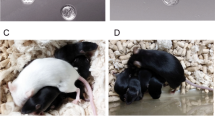Summary
In the present study we have established a pure monolayer culture system of human fallopian tube epithelial cells. The cells were isolated using collagenase digestion, and were cultured in Medium 199 supplemented with 15% fetal bovine serum. The epithelial cells derived from primary and secondary culture were characterized using immunocytochemical staining and electron microscopy. The cells continued to grow for 2 to 3 wk once the monolayer culture of the cells was established. It is currently possible to maintain the cultures until the third generation. Proliferation of these cells was enhanced by epidermal growth factor but not by basic-fibroblast growth factor, insulin, transferrin, estradiol-17β, or progesterone. This culture system offers a good model for determining characteristics of the tubal epithelium and would permit effective study of co-culture with embryos.
Similar content being viewed by others
References
Berchuck, A.; Soisson, A. P.; Olt, G. J., et al. Epidermal growth factor receptor expression in normal and malignant endometrium. Am. J. Obstet. Gynecol. 161:1247–1252; 1989.
Bongso, A.; Chye, N. S. Sathananthan, H., et al. Establishment of human ampullary cell culture. Hum. Reprod. 4:486–494; 1989.
Chegini, N.; Rao, C. V.; Wakim, N., et al. Binding of125I-epidermal growth factors in human uterus. Cell Tissue Res. 246:543–548; 1986.
Dorman, B. H.; Varma, V. A.; Siegfried, J. M., et al. Morphology and growth potential of stromal cell cultures derived from human endometrium. In Vitro Cell. Dev. Biol. 18:919–928; 1982.
Eyestone, W. H.; Leibfried-Rutlegde, M. L.; Northey, D. L., et al. Culture of one- and two-cell bovine embryos to the blastocyst stage in the ovine oviduct. Theriogenology 28:1–7; 1987.
Gandolfi, F.; Moor, M. Stimulation of early embryonic development in the sheep by co-culture with oviduct epithelial cells. J. Reprod. Fertil. 81:23–28; 1987.
Henriksen, T.; Tanbo, T.; Abyholm, T., et al. Epithelial cells from human fallopian tube in culture. Hum. Reprod. 5:25–31; 1990.
Hsu, S. M.; Raine, L.; Fauger, H. The use of avidin-biotin-peroxidase complex (ABC) in immunoperoxidase techniques: a comparison between ABC and unlabeled antibody (PAP) procedures. J. Histochem. Cytochem. 29:577–588; 1981.
Kirk, D.; King, R. J. B.; Heyes, J., et al. Normal human endometrium in cell culture. I. Separation and characterization of epithelial and stromal components in vitro. In Vitro Cell. Dev. Biol. 14:651–662; 1978.
Kirk, D.; King, R. J. B. Normal human endometrium in cell culture. II. A microspectrophotometric study of polyploid nuclei in short-term primary epithelial cultures. In Vitro Cell. Dev. Biol. 15:374–382; 1979.
Laugier, C.; Pageaux, J.; Soto, A. M., et al. Mechanism of estrogen action; indirect effect of estradiol-17β on proliferation of quail oviduct cells. Proc. Natl. Acad. Sci. USA 80:1621–1625; 1983.
Ouhibi, N.; Menezo, Y.; Benet, G., et al. Culture of epithelial cells derived from the oviduct of different species. Hum. Reprod. 4:229–235; 1989.
Rexroad, C. E., Jr.; Powell, A. M. Co-culture of ovine ova with oviductal cells in medium 199. J. Anim. Sci. 66:947–953; 1988.
Rexroad, C. E., Jr. Co-culture of domestic animal embryos. Theriogenology 31:105–114; 1989.
Sumida, C.; Lecerf, F.; Pasqualini, J. R. Control of progesterone receptors in fetal uterine cells in culture: effects of estradiol, progestins, antiestrogens, and growth factors. Endocrinology 122:3–11; 1988.
Tomooka, Y.; Diaugustine, R. P.; McLachlan, J. A. Proliferation of mouse uterine epithelial cells in vitro. Endocrinology 118:1011–1018; 1986.
Varma, V. A.; Melin, S. A.; Adamec, T. A., et al. Monolayer culture of human endometrium: methods of culture and identification of cell types. In Vitro Cell. Dev. Biol. 18:911–918; 1982.
White, K. L.; Hehnke, K.; Rickords, L. F., et al. Early embryonic development in vitro by coculture with oviductal epithelial cells in pigs. Biol. Reprod. 41:425–430; 1989.
Author information
Authors and Affiliations
Rights and permissions
About this article
Cite this article
Takeuchi, K., Maruyama, I., Yamamoto, S. et al. Isolation and monolayer culture of human fallopian tube epithelial cells. In Vitro Cell Dev Biol – Animal 27, 720–724 (1991). https://doi.org/10.1007/BF02633217
Received:
Accepted:
Issue Date:
DOI: https://doi.org/10.1007/BF02633217




